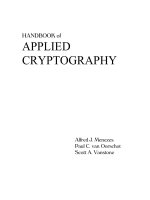- Trang chủ >>
- Đại cương >>
- Kinh tế vĩ mô
handbook of applied algorithms solving scientific engineering and practical problems
Bạn đang xem bản rút gọn của tài liệu. Xem và tải ngay bản đầy đủ của tài liệu tại đây (32.4 MB, 571 trang )
HANDBOOK OF
APPLIED ALGORITHMS
HANDBOOK OF
APPLIED ALGORITHMS
SOLVING SCIENTIFIC,
ENGINEERING AND
PRACTICAL PROBLEMS
Edited by
Amiya Nayak
SITE, University of Ottawa
Ottawa, Ontario, Canada
Ivan Stojmenovi
´
c
EECE, University of Birmingham, UK
A JOHN WILEY & SONS, INC., PUBLICATION
Copyright © 2008 by John Wiley & Sons, Inc. All rights reserved.
Published by John Wiley & Sons, Inc., Hoboken, New Jersey
Published simultaneously in Canada
No part of this publication may be reproduced, stored in a retrieval system, or transmitted in any form or
by any means, electronic, mechanical, photocopying, recording, scanning, or otherwise, except as
permitted under Section 107 or 108 of the 1976 United States Copyright Act, without either the prior
written permission of the Publisher, or authorization through payment of the appropriate per-copy fee to
the Copyright Clearance Center, Inc., 222 Rosewood Drive, Danvers, MA 01923, 978-750-8400, fax
978-750-4470, or on the web at www.copyright.com. Requests to the Publisher for permission should be
addressed to teh Permissions Department, John Wiley & Sons, Inc., 111 River Street, Hoboken, NJ
07030, 201-748-6011, fax 201-748-6008, or online at />Limit of Liability/Disclaimer of Warranty: While the publisher and author have used their best efforts in
preparing this book, they make no representations or warranties with respect to the accuracy or
completeness of the contents of this book and specifically disclaim any implied warranties of
merchantability or fitness for a particular purpose. No warranty may be created or extended by sales
representatives or written sales materials. The advice and strategies contained herein may not be suitable
for your situation. You should consult with a professional where appropriate. Neither the publisher nor
author shall be liable for any loss of profit or any other commerical damages, including but not limited to
special, incidental, consequential, or other damages.
For general information on our other products and services or for technical support, please contact our
Customer Care Department within the United States at 877-762-2974, outside the United States at
317-572-3993 or fax 317-572-4002.
Wiley also publishes its books in a variety of electronic formats. Some content that appears in print may
not be available in electronic formats. For more information about Wiley products, visit our web site at
www.wiley.com.
Library of Congress Cataloging-in-Publication Data:
Handbook of applied algorithms: solving scientific, engineering, and practical
problem / edited by Amiya Nayak & Ivan Stojmenovic.
p. cm.
ISBN 978-0-470-04492-6
1. Computer algorithms. I. Nayak, Amiya. II. Stojmenovic, Ivan.
QA76.9.A43H353 2007
005.1–dc22
2007010253
Printed in the United States of America
10987654321
CONTENTS
Preface vii
Abstracts xv
Contributors xxiii
1. Generating All and Random Instances of
a Combinatorial Object 1
Ivan Stojmenovic
2. Backtracking and Isomorph-Free Generation of Polyhexes 39
Lucia Moura and Ivan Stojmenovic
3. Graph Theoretic Models in Chemistr y and Molecular Biology 85
Debra Knisley and Jeff Knisley
4. Algorithmic Methods for the Analysis of
Gene Expression Data 115
Hongbo Xie, Uros Midic, Slobodan Vucetic, and Zoran Obradovic
5. Algorithms of Reaction–Diffusion Computing 147
Andrew Adamatzky
6. Data Mining Algorithms I: Clustering 177
Dan A. Simovici
7. Data Mining Algorithms II: Frequent Item Sets 219
Dan A. Simovici
8. Algorithms for Data Streams 241
Camil Demetrescu and Irene Finocchi
v
vi CONTENTS
9. Applying Evolutionary Algorithms to Solve
the Automatic Frequency Planning Problem 271
Francisco Luna, Enrique Alba, Antonio J. Nebro, Patrick Mauroy,
and Salvador Pedraza
10. Algorithmic Game Theor y and Applications 287
Marios Mavronicolas, Vicky Papadopoulou, and Paul Spirakis
11. Algorithms for Real-Time Object Detection in Images 317
Milos Stojmenovic
12. 2D Shape Measures for Computer Vision 347
Paul L. Rosin and Joviˇsa
ˇ
Zuni´c
13. Cr yptographic Algorithms 373
Bimal Roy and Amiya Nayak
14. Secure Communication in Distributed Sensor
Networks (DSN) 407
Subhamoy Maitra and Bimal Roy
15. Localiz ed Topology Control Algorithms for Ad Hoc and
Sensor Networks 439
Hannes Frey and David Simplot-Ryl
16. A Novel Admission Control for Multimedia LEO
Satellite Networks 465
Syed R. Rizvi, Stephan Olariu, and Mona E. Rizvi
17. Resilient Recursive Routing in Communication Networks 485
Costas C. Constantinou, Alexander S. Stepanenko,
Theodoros N. Arvanitis, Kevin J. Baughan, and Bin Liu
18. Routing Algorithms on WDM Optical Networks 509
Qian-Ping Gu
Index 535
PREFACE
Although vast activity exists, especially recent, the editors did not find any book
that treats applied algorithms in a comprehensive manner. The editors discovered a
number of graduate courses in computer science programs with titles such as “Design
and Analysis of Algorithms, “Combinatorial Algorithms” “Evolutionary Algorithms”
and “Discrete Mathematics.” However, when glancing through the course contents,
it appears that they were detached from the real-world applications. On the contrary,
recently some graduate courses such as “Algorithms in Bioinformatics” emerged,
which treat one specific application area for algorithms. Other graduate courses heav-
ily use algorithms but do not mention them anywhere explicitly. Examples are courses
on computer vision, wireless networks, sensor networks, data mining, swarm intelli-
gence, and so on.
Generally, it is recognized that software verification is a necessary step in the design
of large commercial software packages. However, solving the problem itself in an
optimal manner precedes software verification. Was the problem solution (algorithm)
verified? One can verify software based on good and bad solutions. Why not start
with the design of efficient solutions in terms of their time complexities, storage, and
even simplicity? One needs a strong background in design and analysis of algorithms
to come up with good solutions.
This book is designed to bridge the gap between algorithmic theory and its ap-
plications. It should be the basis for a graduate course that will contain both basic
algorithmic, combinatorial and graph theoretical subjects, and their applications in
other disciplines and in practice. This direction will attract more graduate students
into such courses. The students themselves are currently divided. Those with weak
math backgrounds currently avoid graduate courses with a theoretical orientation,
and vice versa. It is expected that this book will provide a much-needed textbook for
graduate courses in algorithms with an orientation toward their applications.
This book will also make an attempt to bring together researchers in design and
analysis of algorithms and researchers that are solving practical problems. These com-
munities are currently mostly isolated. Practitioners, or even theoretical researchers
from other disciplines, normally believe that they can solve problems themselves
with some brute force techniques. Those that do enter into different areas looking
for “applications” normally end up with theoretical assumptions, suitable for proving
theorems and designing new algorithms, not having much relevance for the claimed
application area. On the contrary, the algorithmic community is mostly engaged in
their own problems and remains detached from reality and applications. They can
rarely answer simple questions about the applications of their research. This is valid
vii
viii PREFACE
even for the experimental algorithms community. This book should attract both sides
and encourage collaboration. The collaboration should lead toward modeling prob-
lems with sufficient realism for design of practical solutions, also allowing a sufficient
level of tractability.
The book is intended for researchers and graduate students in computer science and
researchers from other disciplines looking for help from the algorithmic community.
The book is directed to both people in the area of algorithms, who are interested
in some applied and complementary aspects of their activity, and people that want
to approach and get a general view of this area. Applied algorithms are gaining
popularity, and a textbook is needed as a reference source for the use by students and
researchers.
This book is an appropriate and timely forum, where researchers from academics
(both with and without a strong background in algorithms) and emerging industry in
new application areas for algorithms (e.g., sensor networks and bioinformatics) learn
more about the current trends and become aware of the possible new applications of
existing and new algorithms. It is often not the matter of designing new algorithms,
but simply the recognition that certain problems have been already solved efficiently.
What is needed is a starting reference point for such resources, which this book could
provide.
Handbook is based on a number of stand-alone chapters that together cover the
subject matter in a comprehensive manner. The book seeks to provide an opportunity
for researchers, graduate students, and practitioners to explore the application of al-
gorithms and discrete mathematics for solving scientific, engineering, and practical
problems. The main direction of the book is to review various applied algorithms
and their currently “hot” application areas such as computational biology, computa-
tional chemistry, wireless networks, and computer vision. It also covers data mining,
evolutionary algorithms, game theory, and basic combinatorial algorithms and their
applications. Contributions are made by researchers from United States, Canada,
United Kingdom, Italy, Greece, Cyprus, France, Denmark, Spain, and India.
Recently, a number of application areas for algorithms have been emerging into
their own disciplines and communities. Examples are computational biology, com-
putational chemistry, computational physics, sensor networks, computer vision, and
others. Sensor networks and computational biology are currently among the top
research priorities in the world. These fields have their own annual conferences
and books published. The algorithmic community also has its own set of annual
meetings, and journals devoted to algorithms. Apparently, it is hard to find a mix-
ture of the two communities. There are no conferences, journals, or even books
with mixed content, providing forum for establishing collaboration and providing
directions.
BRIEF OUTLINE CONTENT
This handbook consists of 18 self-contained chapters. Their content will be described
briefly here.
PREFACE ix
Many practical problems require an exhaustive search through the solution space,
which are represented as combinatorial structuressuchaspermutations,combinations,
set partitions, integer partitions, and trees. All combinatorial objects of a certain
kind need to be generated to test all possible solutions. In some other problems, a
randomly generated object is needed, or an object with an approximately correct
ranking among all objects, without using large integers. Chapter 1 describes fast
algorithms for generating all objects, random object, or object with approximate
ranking, for basic types of combinatorial objects.
Chapter 2 presents applications of combinatorial algorithms and graph theory to
problems in chemistry. Most of the techniques used are quite general, applicable to
other problems from various fields. The problem of cell growth is one of the classical
problems in combinatorics. Cells are of the same shape and are in the same plane,
without any overlap. The central problem in this chapter is the study of hexagonal
systems, which represent polyhexes or benzenoid hydrocarbons in chemistry. An
important issue for enumeration and exhaustive generation is the notion of isomorphic
or equivalent objects. Usually, we are interested in enumerating or generating only
one copy of equivalent objects, that is, only one representative from each isomorphism
class. Polygonal systems are considered different if they have different shapes; their
orientation and location in the plane are not important. The main theme in this chapter
is isomorph-free exhaustive generation of polygonal systems, especially polyhexes.
In general, the main algorithmic framework employed for exhaustive generation is
backtracking, and several techniques have been developed for handling isomorphism
issues within this framework. This chapter presents several of these techniques and
their application to exhaustive generation of hexagonal systems.
Chapter 3 describes some graph-theoretic models in chemistry and molecular biol-
ogy. RNA, proteins, and other structures are described as graphs. The chapter defines
and illustrates a number of important molecular descriptors and related concepts.
Algorithms for predicting biological activity of given molecule and its structure are
discussed. The ability to predict a molecule’s biological activity by computational
means has become more important as an ever-increasing amount of biological infor-
mation is being made available by new technologies. Annotated protein and nucleic
databases and vast amounts of chemical data from automated chemical synthesis and
high throughput screening require increasingly more sophisticated efforts. Finally,
this chapter describes popular machine learning techniques such as neural networks
and support vector machines.
A major paradigm shift in molecular biology occurred recently with the introduc-
tion of gene-expression microarrays that measure the expression levels of thousands
of genes at once. These comprehensive snapshots of gene activity can be used to
investigate metabolic pathways, identify drug targets, and improve disease diagnosis.
However, the sheer amount of data obtained using the high throughput microarray
experiments and the complexity of the existing relevant biological knowledge is be-
yond the scope of manual analysis. Chapter 4 discusses the bioinformatics algorithms
that help analyze such data and are a very valuable tool for biomedical science.
Activities of contemporary society generate enormous amounts of data that are
used in decision-support processes. Many databases have current volumes in the
x PREFACE
hundreds of terabytes. The difficulty of analyzing this kind of data volumes by hu-
man operators is clearly insurmountable. This lead to a rather new area of com-
puter science, data mining, whose aim is to develop automatic means of data anal-
ysis for discovering new and useful patterns embedded in data. Data mining builds
on several disciplines: statistics, artificial intelligence, databases, visualization tech-
niques, and others and has crystallized as a distinct discipline in the last decade
of the past century. The range of subjects in data mining is very broad. Among
the main directions of this branch of computer science, one should mention identi-
fication of associations between data items, clustering, classification, summariza-
tion, outlier detection, and so on. Chapters 6 and 7 concentrate on two classes
of data mining algorithms: clustering algorithms and identification of association
rules.
Data stream processing has recently gained increasing popularity as an effective
paradigm for processing massive data sets. A wide range of applications in compu-
tational sciences generate huge and rapidly changing data streams that need to be
continuously monitored in order to support exploratory analyses and to detect corre-
lations, rare events, fraud, intrusion, unusual, or anomalous activities. Relevant exam-
ples include monitoring network traffic, online auctions, transaction logs, telephone
call records, automated bank machine operations, and atmospheric and astronomical
events. Due to the high sequential access rates of modern disks, streaming algorithms
can also be effectively deployed for processing massive files on secondary storage,
providing new insights into the solution of several computational problems in ex-
ternal memory. Streaming models constrain algorithms to access the input data in
one or few sequential passes, using only a small amount of working memory and
processing each input item quickly. Solving computational problems under these re-
strictions poses several algorithmic challenges. Chapter 8 is intended as an overview
and survey of the main models and techniques for processing data streams and of
their applications.
Frequency assignment is a well-known problem in operations research for which
different mathematical models exist depending on the application-specific conditions.
However, most of these models are far from considering actual technologies currently
deployed in GSM networks, such as frequency hopping. In these networks, interfer-
ences provoked by channel reuse due to the limited available radio spectrum result
in a major impact of the quality of service (QoS) for subscribers. In Chapter 9, the
authors focus on optimizing the frequency planning of a realistic-sized, real-world
GSM network by using evolutionary algorithms.
Methods from game theory and mechanism design have been proven to be a power-
ful mathematical tool in order to understand, control and efficiently design dynamic,
complex networks, such as the Internet. Game theory provides a good starting point
for computer scientists in order to understand selfish rational behavior of complex
networks with many agents. Such a scenario is readily modeled using game theory
techniques, in which players with potentially different goals participate under a com-
mon setting with well-prescribed interactions. Nash equilibrium stands out as the
predominant concept of rationality in noncooperative settings. Thus, game theory
and its notions of equilibria provide a rich framework for modeling the behavior of
PREFACE xi
selfish agents in these kinds of distributed and networked environments and offering
mechanisms to achieve efficient and desirable global outcomes in spite of the selfish
behavior. In Chapter 10, we review some of the most important algorithmic solutions
and advances achieved through game theory.
Real-time face detection in images received growing attention recently. Recogni-
tion of other objects, such as cars, is also important. Applications are in similar and
content-based real-time image retrieval. The task is currently achieved by designing
and applying automatic or semisupervised machine learning algorithms. Chapter 11
will review some algorithmic solutions to these problems. Existing real-time object
detection systems appear to be based primarily on the AdaBoost framework, and this
chapter will concentrate on it. Emphasis is given on approaches that build fast and
reliable object recognizers in images based on small training sets. This is important
in cases where the training set needs to be built manually, as in the case of detecting
back of cars, studied as a particular example.
Existing computer vision applications that demonstrated their validity are mostly
based on shape analysis. A number of shapes, such as linear or elliptic ones, are
well studied. More complex classification and recognition tasks require new shape
descriptors. Chapter 12 reviews some algorithmic tools for measuring and detecting
shapes. Since shape descriptors are expected to be applied not only to a single object
but also to a multiobject or dynamic scene, time complexity of the proposed algorithms
is an issue, in addition to accuracy.
Cryptographic algorithms are extremely important for secure communication over
an insecure channel and have gained significant importance in modern day technol-
ogy. Chapter 13 introduces the basic concepts of cryptography, and then presents
general principles, algorithms, and designs for block and stream ciphers, public key
cryptography, and key agreement. The algorithms largely use mathematical tools from
algebra, number theory, and algebraic geometry and have been explained as and when
required.
Chapter 14 studies the issues related to secure communication among sensor nodes.
The sensor nodes are usually of limited computational ability having low CPU power,
small amount of memory, and constrained power availability. Thus, the standard cryp-
tographic algorithms suitable for state of the art computers may not be efficiently
implemented in sensor nodes. This chapter describes strategies that can work in con-
strained environment. It first presents basic introduction to the security issues in
distributed wireless sensor networks. As implementation of public key infrastructure
may not be recommendable in low end hardware platforms, chapter describes key pre-
distribution issues in detail. Further it investigates some specific stream ciphers for
encrypted communication that are suitable for implementation in low end hardware.
In Chapter 15, the authors consider localized algorithms, as opposed to centralized
algorithms, which can be used in topology control for wireless ad hoc or sensor
networks. The aim of topology control can be to minimize energy consumption, or
to reduce interferences by organizing/structuring the network. This chapter focuses
on neighbor elimination schemes, which remove edges from the initial connection
graph in order to generate energy efficient, sparse, planar but still connected network
in localized manner.
xii PREFACE
Low Earth Orbit (LEO) satellite networks are deployed as an enhancement to ter-
restrial wireless networks in order to provide broadband services to users regardless
of their location. LEO satellites are expected to support multimedia traffic and to
provide their users with some form of QoS guarantees. However, the limited band-
width of the satellite channel, satellite rotation around the Earth, and mobility of
end users makes QoS provisioning and mobility management a challenging task.
One important mobility problem is the intrasatellite handoff management. Chapter
16 proposes RADAR—refined admission detecting absence region, a novel call ad-
mission control and handoff management scheme for LEO satellite networks. A key
ingredient in the scheme is a companion predictive bandwidth allocation strategy that
exploits the topology of the network and contributes to maintaining high bandwidth
utilization.
After a brief review of conventional approaches to shortest path routing, Chapter 17
introduces an alternative algorithm that abstracts a network graph into a logical tree.
The algorithm is based on the decomposition of a graph into its minimum cycle basis
(a basis of the cycle vector space of a graph having least overall weight or length).
A procedure that abstracts the cycles and their adjacencies into logical nodes and
links correspondingly is introduced. These logical nodes and links form the next level
logical graph. The procedure is repeated recursively, until a loop-free logical graph
is derived. This iterative abstraction is called a logical network abstraction procedure
and can be used to analyze network graphs for resiliency, as well as become the basis
of a new routing methodology. Both these aspects of the logical network abstraction
procedure are discussed in some detail.
With the tremendous growth of bandwidth-intensive networking applications, the
demand for bandwidth over data networks is increasing rapidly. Wavelength di-
vision multiplexing (WDM) optical networks provide promising infrastructures to
meet the information networking demands and have been widely used as the back-
bone networks in the Internet, metropolitan area networks, and high capacity local
area networks. Efficient routing on WDM networks is challenging and involves hard
optimization problems. Chapter 18 introduces efficient algorithms with guaranteed
performance for fundamental routing problems on WDM networks.
ACKNOWLEDGMENTS
The editors are grateful to all the authors for their contribution to the quality of this
handbook. The assistance of reviewers for all chapters is also greatly appreciated.
The University of Ottawa (with the help of NSERC) provided an ideal working en-
vironment for the preparation of this handbook. This includes computer facilities
for efficient Internet search, communication by electronic mail, and writing our own
contributions.
The editors are thankful to Paul Petralia and Whitney A. Lesch from Wiley for their
timely and professional cooperation, and for their decisive support of this project. We
thank Milos Stojmenovic for proposing and designing cover page for this book.
PREFACE xiii
Finally, we thank our families for their encouragement, making this effort worth-
while, and for their patience during the numerous hours at home that we spent in front
of the computer.
We hope that the readers will find this handbook informative and worth reading.
Comments received by readers will be greatly appreciated.
Amiya Nayak
SITE, University of Ottawa, Ottawa, Ontario, Canada
Ivan Stojmenovi
´
c
EECE, University of Birmingham, UK
November 2007
ABSTRACTS
1 GENERATING ALL AND RANDOM INSTANCES OF A
COMBINATORIAL OBJECT
Many practical problems require an exhaustive search through the solution space,
which are represented as combinatorial structures, such as, permutations, combina-
tions, set partitions, integer partitions, and trees. All combinatorial objects of a certain
kind need to be generated to test all possible solutions. In some other problems, a
randomly generated object is needed, or an object with an approximately correct
ranking among all objects, without using large integers. Fast algorithms for generat-
ing all objects, random object, or object with approximate ranking for basic types of
combinatorial objects are described.
2 BACKTRACKING AND ISOMORPH-FREE
GENERATION OF POLYHEXES
General combinatorial algorithms and their application to enumerating molecules in
chemistry are presented and classical and new algorithms for the generation of com-
plete lists of combinatorial objects that contain only inequivalent objects (isomorph-
free exhaustive generation) are discussed. We introduce polygonal systems, and how
polyhexes and hexagonal systems relate to benzenoid hydrocarbons. The central
theme is the exhaustive generation of nonequivalent hexagonal systems, which is
used to walk the reader through several algorithmic techniques of general appli-
cability. The main algorithmic framework is backtracking, which is coupled with
sophisticated methods for dealing with isomorphism or symmetries. Triangular and
square systems, as well as the problem of matchings in hexagonal systems and their
relationship to Kékule structures in chemistry are also presented.
3 GRAPH THEORETIC MODELS IN CHEMISTRY
AND MOLECULAR BIOLOGY
The field of chemical graph theory utilizes simple graphs as models of molecules.
These models are called molecular graphs, and quantifiers of molecular graphs are
xv
xvi ABSTRACTS
known as molecular descriptors or topological indices. Today’s chemists use molec-
ular descriptors to develop algorithms for computer aided drug designs, and com-
puter based searching algorithms of chemical databases and the field is now more
commonly known as combinatorial or computational chemistry. With the comple-
tion of the human genome project, related fields are emerging such as chemical
genomics and pharmacogenomics. Recent advances in molecular biology are driv-
ing new methodologies and reshaping existing techniques, which in turn produce
novel approaches to nucleic acid modeling and protein structure prediction. The
origins of chemical graph theory are revisited and new directions in combinato-
rial chemistry with a special emphasis on biochemistry are explored. Of particular
importance is the extension of the set of molecular descriptors to include graph-
ical invariants. We also describe the use of artificial neural networks (ANNs) in
predicting biological functional relationships based on molecular descriptor values.
Specifically, a brief discussion of the fundamentals of ANNs together with an ex-
ample of a graph theoretic model of RNA to illustrate the potential for ANN cou-
pled with graphical invariants to predict function and structure of biomolecules is
included.
4 ALGORITHMIC METHODS FOR THE ANALYSIS OF GENE
EXPRESSION DATA
The traditional approach to molecular biology consists of studying a small number
of genes or proteins that are related to a single biochemical process or pathway.
A major paradigm shift recently occurred with the introduction of gene-expression
microarrays that measure the expression levels of thousands of genes at once. These
comprehensive snapshots of gene activity can be used to investigate metabolic path-
ways, identify drug targets, and improve disease diagnosis. However, the sheer
amount of data obtained using high throughput microarray experiments and the
complexity of the existing relevant biological knowledge is beyond the scope
of manual analysis. Thus, the bioinformatics algorithms that help analyze such
data are a very valuable tool for biomedical science. First, a brief overview of
the microarray technology and concepts that are important for understanding the
remaining sections are described. Second, microarray data preprocessing, an
important topic that has drawn as much attention from the research community as
the data analysis itself is discussed. Finally, some of the more important methods
for microarray data analysis are described and illustrated with examples and case
studies.
5 ALGORITHMS OF REACTION–DIFFUSION COMPUTING
A case study introduction to the novel paradigm of wave-based computing in chem-
ical systems is presented in Chapter 5. Selected problems and tasks of computa-
tional geometry, robotics and logics can be solved by encoding data in configuration
ABSTRACTS xvii
of chemical medium’s disturbances and programming wave dynamics and interac-
tion.
6 DATA MINING ALGORITHMS I: CLUSTERING
Clustering is the process of grouping together objects that are similar. The similarity
between objects is evaluated by using a several types of dissimilarities (particularly,
metrics and ultrametrics). After discussing partitions and dissimilarities, two basic
mathematical concepts important for clustering, we focus on ultrametric spaces that
play a vital role in hierarchical clustering. Several types of agglomerative hierarchical
clustering are examined with special attention to the single-link and complete link
clusterings. Among the nonhierarchical algorithms we present the k-means and the
PAM algorithm. The well-known impossibility theorem of Kleinberg is included
in order to illustrate the limitations of clustering algorithms. Finally, modalities of
evaluating clustering quality are examined.
7 DATA MINING ALGORITHMS II: FREQUENT ITEM SETS
The identification of frequent item sets and of association rules have received a lot
of attention in data mining due to their many applications in marketing, advertis-
ing, inventory control, and many other areas. First the notion of frequent item set is
introduced and we study in detail the most popular algorithm for item set identifi-
cation: the Apriori algorithm. Next we present the role of frequent item sets in the
identification of association rules and examine the levelwise algorithms, an important
generalization of the Apriori algorithm.
8 ALGORITHMS FOR DATA STREAMS
Data stream processing has recently gained increasing popularity as an effective
paradigm for processing massive data sets. A wide range of applications in com-
putational sciences generate huge and rapidly changing data streams that need to
be continuously monitored in order to support exploratory analyses and to detect
correlations, rare events, fraud, intrusion, and unusual or anomalous activities. Rele-
vant examples include monitoring network traffic, online auctions, transaction logs,
telephone call records, automated bank machine operations, and atmospheric and as-
tronomical events. Due to the high sequential access rates of modern disks, streaming
algorithms can also be effectively deployed for processing massive files on secondary
storage, providing new insights into the solution of several computational problems
in external memory. Streaming models constrain algorithms to access the input data
in one or few sequential passes, using only a small amount of working memory
and processing each input item quickly. Solving computational problems under these
restrictions poses several algorithmic challenges.
xviii ABSTRACTS
9 APPLYING EVOLUTIONARY ALGORITHMS TO SOLVE THE
AUTOMATIC FREQUENCY PLANNING PROBLEM
Frequency assignment is a well-known problem in operations research for which dif-
ferent mathematical models exist depending on the application-specific conditions.
However, most of these models are far from considering actual technologies currently
deployed in GSM networks, such as frequency hopping. In these networks, interfer-
ences provoked by channel reuse due to the limited available radio spectrum result in
a major impact of the quality of service (QoS) for subscribers. Therefore, frequency
planning is of great importance for GSM operators. We here focus on optimizing
the frequency planning of a realistic-sized, real-world GSM network by using evo-
lutionary algorithms (EAs). Results show that a (1+10) EA developed by the chapter
authors for which different seeding methods and perturbation operators have been
analyzed is able to compute accurate and efficient frequency plans for real-world
instances.
10 ALGORITHMIC GAME THEORY AND APPLICATIONS
Methods from game theory and mechanism design have been proven to be a powerful
mathematical tool in order to understand, control, and efficiently design dynamic,
complex networks, such as the Internet. Game theory provides a good starting point
for computer scientists to understand selfish rational behavior of complex networks
with many agents. Such a scenario is readily modeled using game theory techniques,
in which players with potentially different goals participate under a common setting
with well prescribed interactions. The Nash equilibrium stands out as the predom-
inant concept of rationality in noncooperative settings. Thus, game theory and its
notions of equilibria provide a rich framework for modeling the behavior of selfish
agents in these kinds of distributed and networked environments and offering mecha-
nisms to achieve efficient and desirable global outcomes despite selfish behavior. The
most important algorithmic solutions and advances achieved through game theory are
reviewed.
11 ALGORITHMS FOR REAL-TIME OBJECT DETECTION IN IMAGES
Real time face detection images has received growing attention recently. Recognition
of other objects, such as cars, is also important. Applications are similar and content
based real time image retrieval. Real time object detection in images is currently
achieved by designing and applying automatic or semi-supervised machine learning
algorithms. Some algorithmic solutions to these problems are reviewed. Existing real
time object detection systems are based primarily on the AdaBoost framework, and
the chapter will concentrate on it. Emphasis is given to approaches that build fast and
reliable object recognizers in images based on small training sets. This is important
ABSTRACTS xix
in cases where the training set needs to be built manually, as in the case of detecting
the back of cars, studied here as a particular example.
12 2D SHAPE MEASURES FOR COMPUTER VISION
Shape is a critical element of computer vision systems, and can be used in many ways
and for many applications. Examples include classification, partitioning, grouping,
registration, data mining, and content based image retrieval. A variety of schemes
that compute global shape measures, which can be categorized as techniques based
on minimum bounding rectangles, other bounding primitives, fitted shape models,
geometric moments, and Fourier descriptors are described.
13 CYPTOGRAPHIC ALGORITHMS
Cryptographic algorithms are extremely important for secure communication over an
insecure channel and have gained significant importance in modern day technology.
First the basic concepts of cryptography are introduced. Then general principles,
algorithms and designs for block ciphers, stream ciphers, public key cryptography,
and protocol for key-agreement are presented in details. The algorithms largely use
mathematical tools from algebra, number theory, and algebraic geometry and have
been explained as and when required.
14 SECURE COMMUNICATION IN DISTRIBUTED SENSOR
NETWORKS (DSN)
The motivation of this chapter is to study the issues related to secure communication
among sensor nodes. Sensor nodes are usually of limited computational ability having
low CPU power, a small amount of memory, and constrained power availability. Thus
the standard cryptographic algorithms suitable for state of the art computers may not
be efficiently implemented in sensor nodes. In this regard we study the strategies that
can work in constrained environments. First we present a basic introduction to the se-
curity issues in distributed wireless sensor networks. As implementation of public key
infrastructure may not be recommendable in low end hardware platforms, we describe
key predistribution issues in detail. Further we study some specific stream ciphers for
encrypted communication that are suitable for implementation in low end hardware.
15 LOCALIZED TOPOLOGY CONTROL ALGORITHMS
FOR AD HOC AND SENSOR NETWORKS
Localized algorithms, in opposition to centralized algorithms, which can be used in
topology control for wireless ad hoc or sensor networks are considered. The aim of
topology control is to minimize energy consumption, or to reduce interferences by
xx ABSTRACTS
organizing/structuring the network. Neighbor elimination schemes, which consist of
removing edges from the initial connection graph are focused on.
16 A NOVEL ADMISSION FOR CONTROL OF MULTIMEDIA
LEO SATELLITE NETWORKS
Low Earth Orbit (LEO) satellite networks are deployed as an enhancement to terres-
trial wireless networks in order to provide broadband services to users regardless of
their location. In addition to global coverage, these satellite systems support commu-
nications with hand-held devices and offer low cost-per-minute access cost, making
them promising platforms for personal communication services (PCS). LEO satel-
lites are expected to support multimedia traffic and to provide their users with some
form of quality of service (QoS) guarantees. However, the limited bandwidth of the
satellite channel, satellite rotation around the Earth and mobility of end-users makes
QoS provisioning and mobility management a challenging task. One important mo-
bility problem is the intra-satellite handoff management. While global positioning
systems (GPS)-enabled devices will become ubiquitous in the future and can help
solve a major portion of the problem, at present the use of GPS for low-cost cellu-
lar networks is unsuitable. RADAR—refined admission detecting absence region—
a novel call admission control and handoff management scheme for LEO satellite
networks is proposed in this chapter. A key ingredient in this scheme is a companion
predictive bandwidth allocation strategy that exploits the topology of the network
and contributes to maintaining high bandwidth utilization. Our bandwidth allocation
scheme is specifically tailored to meet the QoS needs of multimedia connections.
The performance of RADAR is compared to that of three recent schemes proposed
in the literature. Simulation results show that our scheme offers low call dropping
probability, providing for reliable handoff of on-going calls, and good call blocking
probability for new call requests, while ensuring high bandwidth utilization.
17 RESILIENT RECURSIVE ROUTING IN COMMUNICATION
NETWORKS
After a brief review of conventional approaches to shortest path routing an alternative
algorithm that abstracts a network graphintoalogicaltreeisintroduced.Thealgorithm
is based on the decomposition of a graph into its minimum cycle basis (a basis of the
cycle vector space of a graph having least overall weight or length). A procedure that
abstracts the cycles and their adjacencies into logical nodes and links correspondingly
is introduced. These logical nodes and links form the next level logical graph. The
procedure is repeated recursively, until a loop-free logical graph is derived. This
iterative abstraction is called a logical network abstraction procedure and can be used
to analyze network graphs for resiliency, as well as become the basis of a new routing
methodology. Both these aspects of the logical network abstraction procedure are
discussed in some detail.
ABSTRACTS xxi
18 ROUTING ALGORITHMS ON WDM OPTICAL NETWORKS
With the tremendous growth of bandwidth-intensive networking applications, the de-
mand for bandwidth over data networks is increasing rapidly. Wavelength division
multiplexing (WDM) optical networks provide promising infrastructures to meet
the information networking demands and have been widely used as the backbone
networks in the Internet, metropolitan area networks, and high-capacity local area
networks. Efficient routing on WDM networks is challenging and involves hard op-
timization problems. This chapter introduces efficient algorithms with guaranteed
performance for fundamental routing problems on WDM networks.
CONTRIBUTORS
Editors
Amiya Nayak, received his B.Math. degree in Computer Science and Combina-
torics and Optimization from University of Waterloo in 1981, and Ph.D. in Systems
and Computer Engineering from Carleton University in 1991. He has over 17 years
of industrial experience, working at CMC Electronics (formerly known as Canadian
Marconi Company), Defence Research Establishment Ottawa (DREO), EER Sys-
tems and Nortel Networks, in software engineering, avionics, and navigation systems,
simulation and system level performance analysis. He has been an Adjunct Research
Professor in the School of Computer Science at Carleton University since 1994. He
had been the Book Review and Canadian Editor of VLSI Design from 1996 till 2002.
He is in the Editorial Board of International Journal of Parallel, Emergent and Dis-
tributed Systems, and the Associate Editor of International Journal of Computing
and Information Science. Currently, he is a Full Professor at the School of Informa-
tion Technology and Engineering (SITE) at the University of Ottawa. His research
interests are in the area of fault tolerance, distributed systems/algorithms, and mo-
bile ad hoc networks with over 100 publications in refereed journals and conference
proceedings.
Ivan Stojmenovic, received his Ph.D. degree in mathematics in 1985. He earned a
third degree prize at the International Mathematics Olympiad for high school stu-
dents in 1976. He held positions in Serbia, Japan, United States, Canada, France, and
Mexico. He is currently a Chair Professor in Applied Computing at EECE, the
University of Birmingham, UK. He published over 200 different papers, and edited
three books on wireless, ad hoc, and sensor networks with Wiley/IEEE. He is cur-
rently editor of over ten journals, and founder and editor-in-chief of three journals.
Stojmenovic was cited >3400 times and is in the top 0.56% most cited authors in
Computer Science (Citeseer 2006). One of his articles was recognized as the Fast
Breaking Paper, for October 2003 (as the only one for all of computer science), by
Thomson ISI Essential Science Indicators. He coauthored over 30 book chapters,
mostly very recent. He collaborated with over 100 coauthors with Ph.D. and a num-
ber of their graduate students from 22 different countries. He (co)supervised over
40 Ph.D. and master theses, and published over 120 joint articles with supervised
students. His current research interests are mainly in wireless ad hoc, sensor, and
cellular networks. His research interests also include parallel computing, multiple-
valued logic, evolutionary computing, neural networks, combinatorial algorithms,
computational geometry, graph theory, computational chemistry, image processing,
xxiii
xxiv CONTRIBUTORS
programming languages, and computer science education. More details can be seen
at www.site.uottawa.ca/∼ivan.
Authors
Andrew Adamatzky, Faculty of Computing, Engineering and Mathemati-
cal Science University of the West of England, Bristol, BS16 1QY, UK
[]
Enrique Alba, Dpto. de Lenguajes y Ciencias de la Computaci
´
on, E.T.S.
Ing. Inform
´
atica, Campus de Teatinos, 29071 M
´
alaga, Spain [
www.lcc.uma.es/∼eat.]
Theodoros N. Arvanitis, Electronics, Electrical, and Computer Engineer-
ing, University of Birmingham, Edgbaston, Birmingham B15 2TT, UK
[]
Kevin J. Baughan, Electronics, Electrical, and Computer Engineering, University of
Birmingham, Edgbaston, Birmingham B15 2TT, UK
Costas C. Constantinou, Electronics, Electrical, and Computer Engineering, Uni-
versity of Birmingham, and Prolego Technologies Ltd., Edgbaston, Birmingham B15
2TT, UK []
Camil Demetrescu, Department of Computer and Systems Science, Univer-
sity of Rome “La Sapienza”, Via Salaria 113, 00198 Rome, Italy [demetres
@dis.uniroma1.it]
Irene Finocchi, Department of Computer and Systems Science, University of Rome
“La Sapienza”, Via Salaria 113, 00198 Rome, Italy
Hannes Frey, Department of Mathematics and Computer Science, Univer-
sity of Southern Denmark, Campusvej 55, DK-5230 Odense M, Denmark
[]
Qianping Gu, Department of Computing Science, Simon Fraser University, Burnaby,
BC V5A 1S6, Canada []
Debra Knisley, Department of Mathematics, East Tennessee State University,
Johnson City, TN 37614-0663, USA []
Jeff Knisley, Department of Mathematics, East Tennessee State University, Johnson
City, TN 37614-0663, USA []
Bin Liu, Electronics, Electrical, and Computer Engineering, University of Birming-
ham, Edgbaston, Birmingham B15 2TT, UK
Francisco Luna, Universidad de M
´
alaga, ETS. Ing. Inform
´
atica, Campus de Teatinos,
29071 M
´
alaga, Spain [fl]









